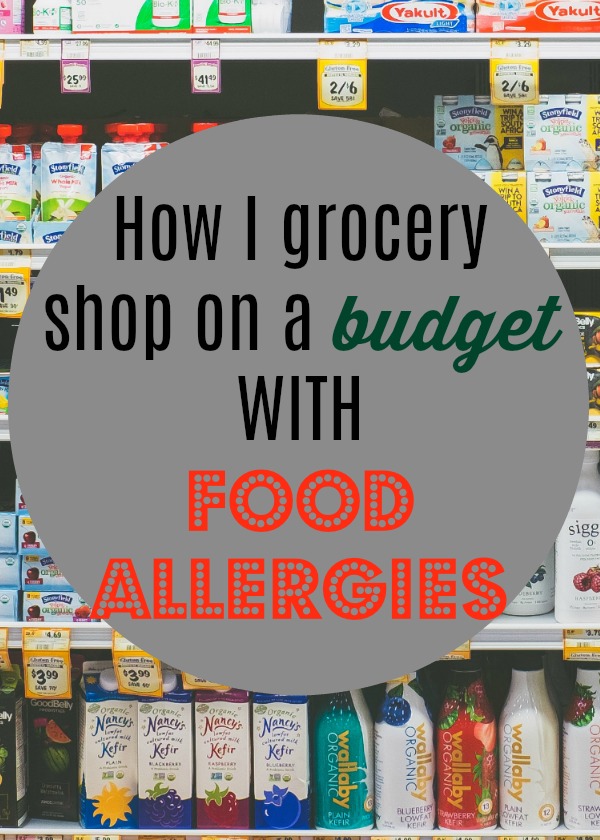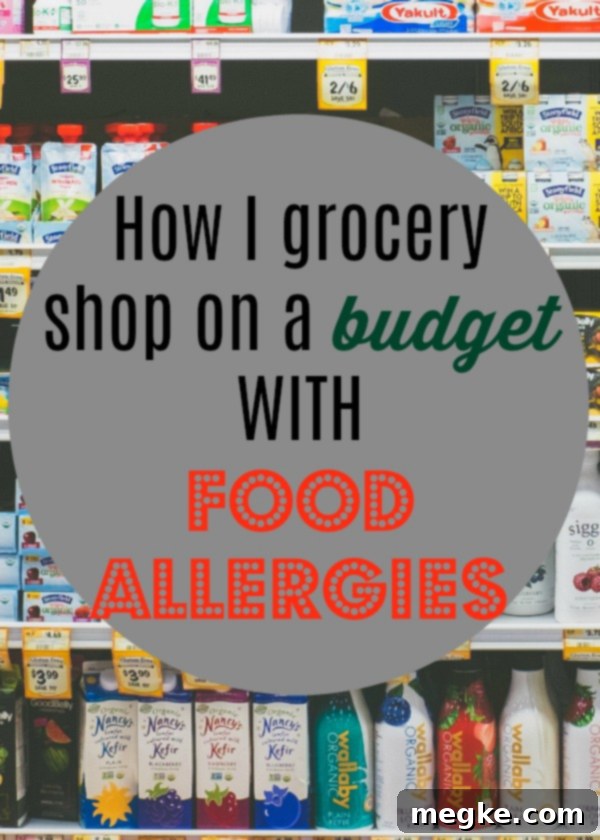Mastering Budget-Friendly Grocery Shopping with Food Allergies
Navigating the grocery store with severe food allergies can feel like an impossible mission, especially when you’re trying to stick to a budget. Specialty allergy-friendly ingredients often cost two to three times more than their conventional counterparts, making it challenging to keep your family fed without breaking the bank. As an allergy mom who manages over 30 food allergies and EOE for my family, I deeply understand this struggle. But I’m here to tell you it’s entirely possible to eat well, safely, and affordably. I’m going to share my top five tried-and-true strategies that help my family of five stay within budget, week after week. From one allergy parent to another, you’ve got this!

Below, I’ve summarized my most effective tips for grocery shopping with food allergies while staying on budget. For an even more detailed walkthrough and to see exactly what I buy for a week’s worth of groceries for my family, be sure to watch the accompanying video.
Our Top 5 Tips for Budget-Friendly Allergy Grocery Shopping:
-
Plan Out Your Dinners with Precision
I know, meal planning can seem daunting and time-consuming. It’s often the first thing to fall by the wayside during a busy week. However, for families managing food allergies, meticulous meal planning is not just a suggestion; it’s a financial lifesaver. Without a clear plan, you risk impulse buys, unnecessary spending on specialty items you don’t truly need, or worse, resorting to expensive, allergy-risky takeout when hunger strikes.
To make it a sustainable habit, I designate one evening a week – every Sunday night – for meal planning. This ensures it’s built into my routine and doesn’t feel like an extra chore. By Monday morning, when I typically do my grocery pickup, I have a complete plan for the week’s dinners, a corresponding shopping list, and peace of mind. This proactive approach saves countless dollars by preventing last-minute, emergency grocery runs or costly restaurant meals that often come with cross-contamination risks.
A common concern is writing a meal plan but then not following through. My secret? I factor in our family’s schedule. On each day’s line, I jot down any activities happening around dinner time. If we have dance class, soccer practice, or an evening appointment, I know I’ll need a quicker, low-effort meal. This might mean a sheet pan dinner, a slow cooker meal prepped earlier in the day, or an Instant Pot recipe. This simple adjustment ensures I choose meals that are realistic for our schedule, increasing the likelihood of actually cooking them and avoiding wasted ingredients or takeout temptations. It’s an effort upfront, but the savings and reduced stress throughout the week are invaluable.
-
Shop Your Pantry (and Fridge!) First
This strategy is a powerful companion to meal planning. Once I’ve mapped out our dinners and listed all the ingredients needed for each, my next step is to conduct a thorough inventory of my pantry, refrigerator, and freezer. I literally go through my shelves and drawers, crossing off every ingredient I already have on hand. You’d be surprised how much you discover you already own!
This isn’t just about finding exact matches. It’s also about flexibility and preventing food waste. For example, if I notice a bunch of cilantro looking a bit sad, I might strategically move “taco night” up in the week’s meal plan to ensure we use it before it spoils, rather than buying a fresh bunch only to let the old one go bad. Similarly, I might find a half-used carton of allergy-friendly milk alternative or a bag of frozen vegetables I’d forgotten about. By “shopping from myself first,” I often realize I need significantly fewer items than I initially thought, leading to a much shorter and cheaper grocery list. This habit not only saves money but also significantly reduces food waste, which is a big win for both your wallet and the environment.
-
Embrace the Power of Leftovers
Alright, I know what you’re thinking – “leftovers again?” I can almost hear the eye-rolls! But seriously, if you’ve put in the effort to cook a delicious, allergy-friendly meal from scratch, throwing out the leftovers is not just a waste of food, it’s a waste of your time, effort, and money. Plus, here’s the best part: leftovers make for the absolute EASIEST lunch imaginable. I eat leftovers almost every single day for lunch, and it’s a game-changer.
Why would I want to spend extra time making a separate lunch for myself after cooking dinner from scratch? No thanks! A quick pop in the microwave, and I have a healthy, safe, and delicious allergy-friendly lunch ready to go. The financial savings from consistently eating leftovers instead of buying or preparing separate lunches add up dramatically over time. It’s about weighing your priorities: would you rather have your absolute favorite, newly-prepared lunch every day, or save that money to take your kids on fun outings and experiences? For me, the choice is clear. It’s a small adjustment that yields huge returns, both in terms of money and precious time.
-
Prioritize Regular Ingredients Over Specialty Brands
Let me be clear: I absolutely adore many allergy-friendly specialty brands. The convenience and peace of mind that comes with a safe granola bar or a pre-made gluten-free bread are invaluable. However, I categorize these items as “luxuries” rather than weekly staples. They are reserved for specific needs, special occasions, or as occasional treats, not as routine grocery list items.
Instead, I make a conscious effort to buy as many regular, naturally allergy-friendly ingredients as possible. My kids have learned to enjoy snacks that are inherently safe and inexpensive, such as fruits, vegetables, or even simple chips and salsa, rather than relying solely on pricey, processed allergy-friendly alternatives. This shift in mindset extends to meal components too. Focus on whole foods – fresh produce, lean proteins, and safe grains – that form the foundation of healthy, budget-friendly meals.
I also limit my trips to specialty grocery stores to every few weeks, rather than every week. The sheer abundance of tempting specialty foods makes it far too easy to overspend. When I do go, I arrive with a very specific list and stick to it rigidly. By focusing on whole, unprocessed ingredients that are naturally free of allergens, you can significantly cut down on your grocery bill. (If you’re looking for a list of allergy-friendly snacks my kids regularly enjoy, you can check out this detailed post.)
-
Freeze What You Don’t Use, and Use What You Freeze!
Freezing is your secret weapon against food waste and a fantastic way to create your own “convenience foods” that are guaranteed to be safe for your family’s allergies. When I make a large batch of soup, stew, or a sauce, I always freeze the extras. This is particularly helpful if I already have a fridge full of leftovers that need to be eaten, ensuring nothing goes to waste and my fridge can actually close!
Having a freezer stocked with safe, pre-made meals is an absolute godsend for those inevitable “real life” days. When someone in the family is sick (especially me!), or when an unexpected event throws off our schedule, the last thing an allergy family can do is simply call for a pizza or run to a restaurant. Our convenience options are limited and often unsafe. That’s where your frozen stash becomes invaluable – just warm something up, and a healthy, safe meal is ready with minimal effort.
To maximize this tip, I keep a running list on my freezer door. I note down everything I put in, including the date and portion size. This prevents items from getting lost in the back and forgotten. Then, during my meal planning sessions, I consult this list. For instance, if I’m planning to make allergy-friendly fried chicken, I might remember I have half a loaf of cornbread in the freezer that would be perfect to serve alongside it. This thoughtful approach ensures nothing is wasted and that you always have safe, ready-to-eat options.
These tips, while simple, have been incredibly effective in helping my family manage our food allergies without blowing our budget. Remember, consistent small efforts lead to significant long-term savings and reduced stress.
For even more visual details and to see these strategies in action, be sure to watch the full video below (or on YouTube)!
———-> Have you ever tried grocery pick-up? I’m a huge fan, and it’s one of the time-saving strategies I mention in the video. If you’ve never used it, you absolutely have to! Use my affiliate link and you can get $10 off your first order at Wal-Mart’s grocery pick up!
If you’d like to recreate the exact meal plan I used for my family, here are links to all the dinner recipes I purchased groceries for. This will help you find the ingredients and replicate the savings:
- Quinoa Teriyaki Skillet Meatballs
- 30 Minute Sausage and Peppers Pasta
- Lo Mein
- Instant Pot Gluten-free Red Beans & Rice
- Chicken Pot Pie Soup
- Allergy-friendly 30 Minute Salsa Chicken Sheet Pan Dinner
- Slow Cooker San Fran Pork Chops
*****For even more structured savings, if you’d like a two-week dinner menu complete with a grocery shopping list, all designed to keep you under $200, then be sure to purchase my exclusive e-book! It’s packed with allergy-friendly recipes and a budget-conscious plan.*****
Lastly, your experience can help others! Please be sure to leave your best tips for staying on budget while grocery shopping with food allergies in the comments section below. Your insights could be incredibly valuable to future readers facing similar challenges.
DON’T FORGET TO PIN THIS ARTICLE, SO YOU CAN EASILY FIND THESE TIPS LATER. ALSO, BE SURE TO CHECK OUT MY OTHER ALLERGY-FRIENDLY PINTEREST BOARDS FOR MORE INSPIRATION.

Craving Inexpensive, Allergy-Friendly Treats? Make Them Yourself!
Specialty treats can be notoriously expensive. Why not make your own safe and delicious snacks at home? Here are a few of our family’s favorite go-to recipes that are both allergy-friendly and budget-conscious:
How to Make Jello Pudding Dairy Free (Top-8-Free Too!)
Allergy-friendly Rice Krispies (Top 8 Free)
Happy Trails Mix (Nut, DF, Top 8 Free)
Gluten, Dairy & Oat-free Energy Balls
What in the World Do You Feed Your Kids: Candy
